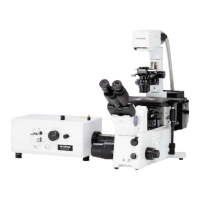Getting Started FLUOVIEW/Basic Operations
IV.
OPERATION INSTRUCTIONS
IV .
1-2
Page
1: 60Pm
2: 100Pm
3: 150Pm
4: 200Pm
5: 300Pm
Basically, the resolution in the Z-axis direction cannot be improved by selecting a
smaller confocal aperture than the confocal aperture size recommended for each
objective. However, this sometimes improves the resolution in the X-Y plane. The
results vary depending on many conditions such as the specimen’s reflectivity and light
scattering properties.
The following table shows the objectives and the confocal aperture numbers
recommended for them.
Objective N.A. Confocal Aperture Number
PLAPO 40X 0.95 2
PLAPO 60XO 1.4 2
PLAPO 100XO 1.4 3
PLAPO 40XWLSM 0.9 2
PLAPO 60XWLSM 1.0 3
PLAPO 60XOLSM 1.1 3
UPLAPO 10X 0.4 1
UPLAPO 20X 0.7 1
UPLAPO 20XO 0.8 1
UPLAPO 40X 0.85 2
UPLAPO 40XOI 1.0 2
UPLAPO 60X 0.9 3
UPLAPO60 X W 1.2 2
UPLAPO 60XWPSF 1.2 2
UPLAPO 100XOI 1.35 3
UPLFL10X 0.3 1
UPLFL20X 0.5 2
UPLFL40X 0.75 3
UPLFL60XOI 1.25 2
UPLFL100XO 1.3 3
UPLFL100XOI 1.3 3
UMPLFL10XW 0.3 1
UMPLFL20XW 0.5 2
LUMPLFL40XW 0.8 2
LUMPLFL60XW 0.9 3
The confocal aperture sizes recommended for objectives
are 1, 2 or 3 as shown in the following table.
Use these sizes when the observation image is dark and a
brighter image is required. Confocality is compromised in
this case.
°
¿
°
¾
½
¿
¾
½

